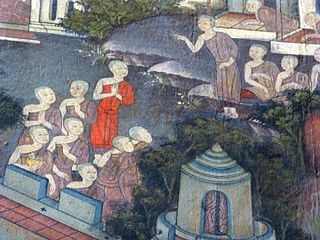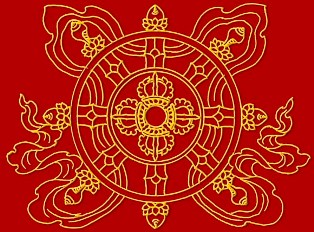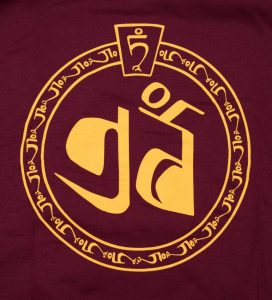Related Research Articles

Tibetan Buddhism is the form of Buddhism practiced in Tibet and Bhutan, where it is the dominant religion. It is also in majority regions surrounding the Himalayas ,in much of Central Asia, in the Southern Siberian regions such as Tuva, and in Mongolia.
The purpose of this timeline is to give a detailed account of Buddhism from the birth of Gautama Buddha to the present.

Geshe Kelsang Gyatso was a Buddhist monk, meditation teacher, scholar, and author. He was the founder and spiritual director of the New Kadampa Tradition-International Kadampa Buddhist Union (NKT-IKBU), a registered non-profit, modern Buddhist organization that came out of the Gelugpa school/lineage. 1,300 centres around the world, including temples, city temples and retreat centres offer an accessible approach to ancient wisdom.
Thubten Kunga Ling Center (TKC), is a Buddhist Center in Deerfield Beach, Florida. TKC follows the Gelugpa tradition of Tibetan Buddhism, which is the lineage of the Dalai Lama. The center offers classes on meditation and Buddhist philosophy. The resident teacher is Venerable Lhundub Tendron.

The New Kadampa Tradition – International Kadampa Buddhist Union (NKT—IKBU) is a global Buddhist new religious movement founded by Kelsang Gyatso in England in 1991. In 2003 the words "International Kadampa Buddhist Union" (IKBU) were added to the original name "New Kadampa Tradition". The NKT-IKBU is an international organisation registered in England as a charitable, or non-profit, company. It currently lists more than 200 centres and around 900 branch classes/study groups in 40 countries. The BBC describe the New Kadampa Tradition as "one of the major Buddhist schools in the UK, founded by the Tibetan-born Geshe Kelsang Gyatso."

The Foundation for the Preservation of the Mahayana Tradition (FPMT) was founded in 1975 by Lamas Thubten Yeshe and Thubten Zopa Rinpoche, who began teaching Mahayana Buddhism to Western students in Nepal. The FPMT has grown to encompass over 160 dharma centers, projects, and services in 37 countries. Since the death of Lama Yeshe in 1984, the FPMT's spiritual director has been Lama Zopa Rinpoche.
Geshe or geshema is a Tibetan Buddhist academic degree for monks and nuns. The degree is emphasized primarily by the Gelug lineage, but is also awarded in the Sakya and Bön traditions. The equivalent geshema degree is awarded to women.
The Pratimokṣa is a list of rules governing the behaviour of Buddhist monastics. Prati means "towards" and mokṣa means "liberation" from cyclic existence (saṃsāra).

Jetsunma Tenzin Palmo is a bhikṣuṇī in the Drukpa Lineage of the Kagyu school of Tibetan Buddhism. She is an author, teacher and founder of the Dongyu Gatsal Ling Nunnery in Himachal Pradesh, India. She is best known for being one of the very few Western yoginis trained in the East, having spent twelve years living in a remote cave in the Himalayas, three of those years in strict meditation retreat.
The International Congress on Buddhist Women's Role in the Sangha: Bhikshuni Vinaya and Ordination Lineages was an historic event that took place July 18–20, 2007. It was a meeting of internationally recognized Buddhist scholars specializing in monastic discipline and history, as well as practitioners. It was expected to be the final discussion of a decades-long dialogue about re-establishing full bhikshuni ordination in Buddhist traditions. Papers and research based on Buddhist texts and contemporary practice traditions in China, Korea, Taiwan, Tibet, and South Asia were presented, between them the Abstract: The Eight Garudhammas. The fourteenth Dalai Lama attended the final day of the conference and conclusions. His letter of support is available to the public.

Thubten Chodron, born Cheryl Greene, is an American Tibetan Buddhist nun, author, teacher, and the founder and abbess of Sravasti Abbey, the only Tibetan Buddhist training monastery for Western nuns and monks in the United States. Chodron is a central figure in the reinstatement of the Bhikshuni ordination of women. She is a student of the 14th Dalai Lama, Tsenzhab Serkong Rinpoche, Lama Thubten Yeshe, Thubten Zopa Rinpoche, and other Tibetan masters. She has published many books on Buddhist philosophy and meditation, and is co-authoring with the Dalai Lama a multi-volume series of teachings on the Buddhist path, The Library of Wisdom and Compassion.

Women in Buddhism is a topic that can be approached from varied perspectives including those of theology, history, anthropology, and feminism. Topical interests include the theological status of women, the treatment of women in Buddhist societies at home and in public, the history of women in Buddhism, and a comparison of the experiences of women across different forms of Buddhism. As in other religions, the experiences of Buddhist women have varied considerably.

Sravasti Abbey, the first Tibetan Buddhist monastery for Western nuns and monks in the U.S., was established in Washington State by Bhikshuni Thubten Chodron in 2003. Whilst practicing in the Tibetan Buddhist Tradition, Sravasti Abbey monastics ordain in the Dharmaguptaka Vinaya. It is situated on 300 acres (1.2 km2) of forest and meadows, 11 miles (18 km) outside of Newport, Washington, near the Idaho state line. It is open to visitors who want to learn about community life in a Tibetan Buddhist monastic setting.
Manjushri Institute was a large Buddhist college situated at Conishead Priory in Cumbria, England from 1976 until its dissolution in 1991. In 1991 its assets, including Conishead Priory, were transferred to a new centre on the same premises, Manjushri Mahayana Buddhist Centre, which was later renamed Manjushri Kadampa Meditation Centre.
The Eight Garudhammas are additional precepts required of bhikkhunis above and beyond the monastic rule (vinaya) that applied to monks. Garu, literally means "heavy" and when applied to vinaya, it means "heavy offense that entails penance (mānatta) consisting of 2 weeks" as described in garudhamma rule No. 5. The authenticity of these rules is contested; they were supposedly added to the (bhikkhunis) Vinaya "to allow more acceptance" of a monastic Order for women, during the Buddha's time. They are controversial because they attempt to push women into an inferior role and because many Buddhists, especially Bhikkhunis, have found evidence that the eight Garudhammas are not really the teachings of Gautama Buddha.

Carola Roloff is a German Buddhist nun. Her monastic name is Bhiksuni Jampa Tsedroen. An active teacher, translator, author, and speaker, she is instrumental in campaigning for equal rights for Buddhist nuns.

The Tibetan Nuns Project, founded in 1987, is a non-profit organization dedicated to educating and supporting female Buddhist monastics in India from all Tibetan Buddhist lineages. It helps nuns who want to study and advance their ordination. The Tibetan Nuns Project's mission is to educate and empower Tibetan Buddhist nuns as teachers and leaders, as well as to establish, strengthen, and support educational institutions in order to preserve Tibetan religion and culture. In India, the organization supports seven nunneries and over 800 nuns.
Geshe Tenzin Zopa is a Nepalese Tibetan Buddhist monk of the Mahayana tradition. He is the resident teacher of the Losang Dragpa Centre of the Foundation for the Preservation of the Mahayana Tradition (FPMT). Zopa is featured in the 2008 documentary film Unmistaken Child, which follows his search for the reincarnation of his beloved master, Geshe Lama Konchog. Zopa has also written a book about this search, titled Precious Holy Child of Kopan.
A bhikkhunī or bhikṣuṇī is a fully ordained female monastic in Buddhism. Male monastics are called bhikkhus. Both bhikkhunis and bhikkhus live by the Vinaya, a set of rules. Until recently, the lineages of female monastics only remained in Mahayana Buddhism and thus are prevalent in countries such as China, Korea, Taiwan and Vietnam but a few women have taken the full monastic vows in the Theravada and Vajrayana schools over the last decade. From conservative perspectives, none of the contemporary bhikkuni ordinations in Thailand or Tibet are valid.
Geshema Lobzang Chhodon is a Tibetan Buddhist nun from the Spiti valley, India. She belongs to the first batch of nuns in history to have received the Geshema degree, equivalent to a doctoral degree in the Tibetan Buddhist monastic system, and is the first nun from the historically Tibetan Buddhist region of Spiti to have earned this degree. Lobzang Zangmo received her Geshema degree alongside nineteen other nuns from the 14th Dalai Lama during a ceremony at the Drepung monastic college in Mundgod, south India, in December 2016. Of these nuns, eleven were from Tibet; six from India ; two from Nepal, and one from Bhutan.
References
- ↑ Amy Yee. "Breaking Through". Lion's Roar-Buddhist's Wisdom for Our Time. Retrieved June 19, 2015.
- 1 2 3 4 5 "The Joy of Study: An Interview with Geshe Kelsang Wangmo". FPMT. Retrieved 2021-12-22.
- ↑ Haas, Michaela (2011-05-18). "2,500 Years After The Buddha, Tibetan Buddhists Acknowledge Women". Huffington Post.
- 1 2 3 "Geshe Kelsang Wangmo, An Interview with the World's First Female Geshe « Mandala Publications". Mandalamagazine.org. Archived from the original on 2018-01-27. Retrieved 2014-08-25.
- ↑ "The Teachers of Tushita" . Retrieved June 19, 2015.
- ↑ "Geshe Kelsang Wangmo | Website" . Retrieved 2021-12-22.
- ↑ "Geshema Degree". Tibetan Nuns Project. Retrieved 2021-12-22.
- 1 2 3 4 5 6 7 8 9 10 11 LeClear, McKenna (2013-04-01). "Bhikshunis and Breaking Barriers: The Changing Status of Women in Monastic Life". Independent Study Project (ISP) Collection.
- 1 2 Carola Roloff (2017). "Women, Ordination, and a Buddhist Perspective: A Violation of Rights?". Religious Studies and Theology. 36 (2): 187–210. doi:10.1558/rsth.35158.
- ↑ Barnes, Nany (2000). "The Nuns at the Stupa: Inscriptional Evidence for the Lives and Activities of Early Buddhist Nuns in India". Women's Buddhism Buddhism's Women: Tradition, Revision, Renewal, ed. Ellison Banks Findly– via (Boston: Wisdom Publications, 2000).
- 1 2 "Debate Moves Forward on Full Ordination for Nuns" (PDF). Tibetan Nuns Project Newsletter. Winter 2008. Retrieved 22 December 2021.
- ↑ Berzin, Alexander (2012). "A Summary Report of the 2007 International Congress on the Women's Role in the Sangha: Bhikshuni Vinaya and Ordination Lineages". The Berzin Archives: The Buddhist Archives of Dr. Alexander Berzin.
- 1 2 "Geshema and Khenmo Degrees" (PDF). Tibetan Nuns Project Newsletter. Fall 2009. Retrieved 22 December 2021.
- 1 2 3 "What is a Geshe?". FPMT. Retrieved 2021-12-22.
- ↑ "Historic Decision to Grant Degree" (PDF). Tibetan Nuns Project Newsletter. Fall 2012.
- ↑ "Geshema Kelsang Wangmo: Becoming the First Female Geshe". The Wisdom Experience. Retrieved 2021-12-22.